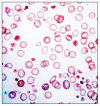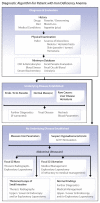Iron deficiency anemia
Abstract
Iron is essential to virtually all living organisms and is integral to multiple metabolic functions. The most important function is oxygen transport in hemoglobin. Iron deficiency anemia in dogs and cats is usually caused by chronic blood loss and can be discovered incidentally as animals may have adapted to the anemia. Severe iron deficiency is characterized by a microcytic, hypochromic, potentially severe anemia with a variable regenerative response. Iron metabolism and homeostasis will be reviewed, followed by a discussion of diagnostic testing and therapeutic recommendations for dogs and cats with iron deficiency anemia.
Anémie ferriprive. Le fer est essentiel pour presque tous les organismes vivants et il fait partie intégrante de multiples fonctions métaboliques. La fonction la plus importante est le transport de l’oxygène dans l’hémoglobine. L’anémie ferriprive chez les chiens et les chats est habituellement causée par une perte de sang chronique et peut être découverte incidemment car les animaux peuvent s’être adaptés à l’anémie. Une carence en fer grave est caractérisée par une anémie microcytique, hypochromique et potentiellement grave avec une réponse régénérative variable. Le métabolisme du fer et l’homéostase seront examinés, suivis d’une analyse des épreuves diagnostiques et des recommandations thérapeutiques pour les chiens et les chats atteints d’anémie ferriprive.
(Traduit par Isabelle Vallières)
Figures
References
-
- Crichton R. Iron Metabolism: From Molecular Mechanisms to Clinical Consequences. 3rd ed. 17–56. West Sussex, UK: John Wiley and Sons; 2009. pp. 141–325.
-
- Harvey JW. Iron metabolism and its disorders. In: Kaneko JJ, Harvey JW, Bruss ML, editors. Clinical Biochemistry of Domestic Animals. 6th ed. Burlington, Massachusetts: Elsevier; 2008. pp. 259–285.
-
- Harvey JW. Microcytic anemia. In: Feldman BF, Zinkl JG, Jain MC, editors. Schalm’s Veterinary Hematology. 5th ed. Philadephia, Pennsylvania: Lippincott, Williams and Wilkins; 2000. pp. 200–204.
-
- Weiss DJ. Iron and copper deficiencies and disorders of iron metabolism. In: Weiss DJ, Wardrop KJ, editors. Schalm’s Veterinary Hematology. 6th ed. Ames: Blackwell Publishing; 2010. pp. 167–171.
Publication types
MeSH terms
Substances
Grants and funding
LinkOut - more resources
Full Text Sources
Other Literature Sources
Medical
Miscellaneous




